People could be misinterpreting how Britain’s social classes intend to vote if they use the two classifications interchangeably
In the mid-20th century the National Readership Society developed a way of classifying people based on the occupation of the head of the household. The system is known as the NRS social grade, and poll followers are likely to be familiar with its groupings ABC1 and C2DE.
The measure is widely used in market research and the ABC1 and C2DE are often used as shorthand to refer to the middle class and working class respectively.
The problem is that the NRS social grade was never designed to describe class.
If you asked a Briton to describe their social characteristics you would rarely hear someone say “ABC1” or “C2DE”, but you would probably hear them say “middle class” and “working class”.
So to what extent do NRS grades match up with the people’s own class identity? YouGov Profiles data allows us to explore how much the classifications overlap.
NRS grade does not line up very well with people’s own class identity
Most Britons (57%) are in the ABC1 category, with C2DEs making up the remaining 43%. Yet ask Britons what class they are and you are more likely to hear “working class” (51%) than “middle class” (39%). Some 1% of Britons consider themselves upper class, and the remainder don’t know.
In terms of overlap, the results show that barely half of ABC1s (51%) consider themselves middle class, while 41% identify as working class.
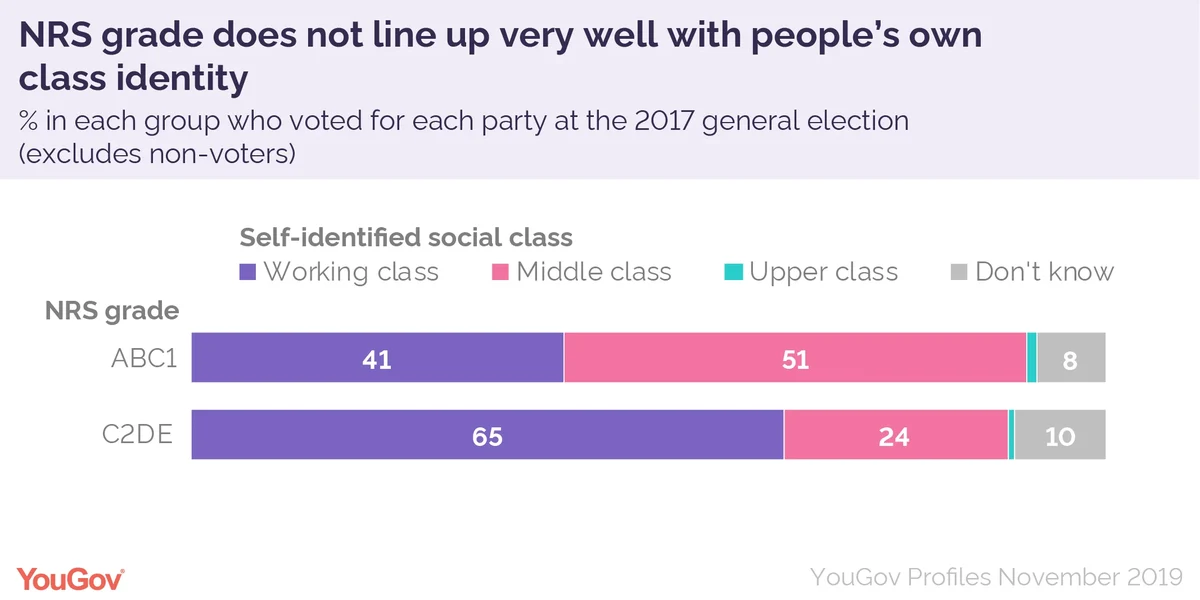
The C2DE label corresponds more closely, but even so, fewer than two thirds (65%) of people in this group consider themselves working class. A quarter (24%) believe themselves to be middle class.
Looking at these groups as a proportion of the population as a whole we can see that a third of the British public sit in ‘counterintuitive’ groups, i.e. ABC1 working class (23%) or C2DE middle class (11%).
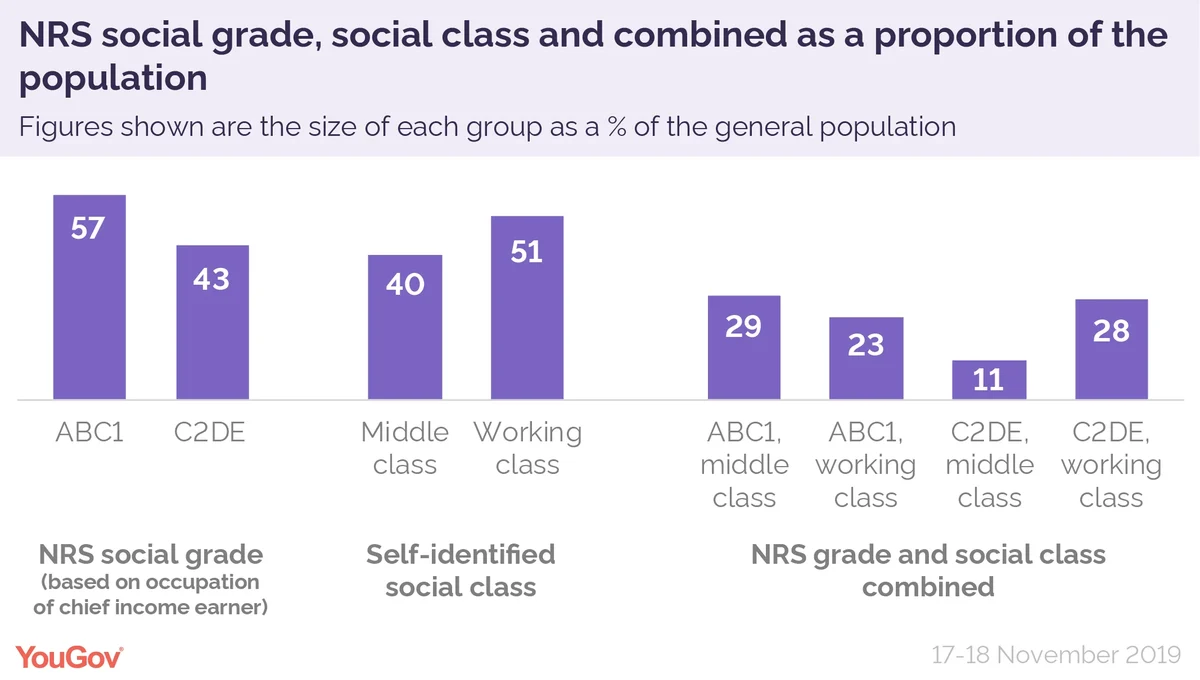
Differences in voting behaviour
With an election campaign in full swing, people have been arguing about the way NRS grade is used when presenting voting intention results. So how would breaking down the results by class identity differ from the ABC1/C2DE results currently shown?
Looking at current voting intention, the results show a noticeable discrepancy between ABC1 voters and middle class voters. While the Conservative vote is similar in both groups (41-42%) the Labour/Lib Dem split is different. Among ABC1s Labour holds an eleven point lead, on 28% to 17% for the Lib Dems. Among middle class people this lead vanishes, with the two parties holding a near-identical 24% and 23% of the vote respectively.
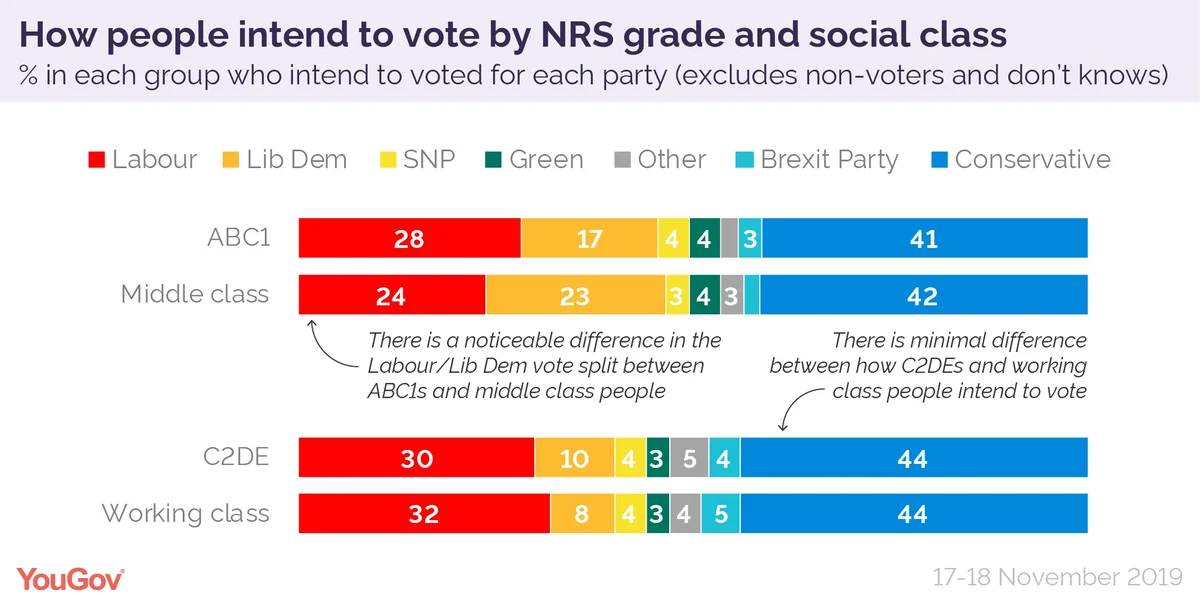
The difference between C2DE voters and working class voters is so small as to be within the margin of error. This is less surprising given that the C2DE-working class correlation is much stronger than the ABC1-middle class one.
Digging deeper still reveals that in terms of the left-wing vote, Britons have much more similar voting behaviour to those in a different NRS grade but who share the same class identity as they do than with those in the same NRS grade but have a different class identity.
For instance, among ABC1s who describe themselves as middle class people, 25% intend to vote Labour and 23% Lib Dem. This is much more similar to how C2DE middle class people intend to vote (21% Labour, 20% Lib Dem) than it is to how ABC1 working class people intend to vote (31% Labour, 10% Lib Dem).
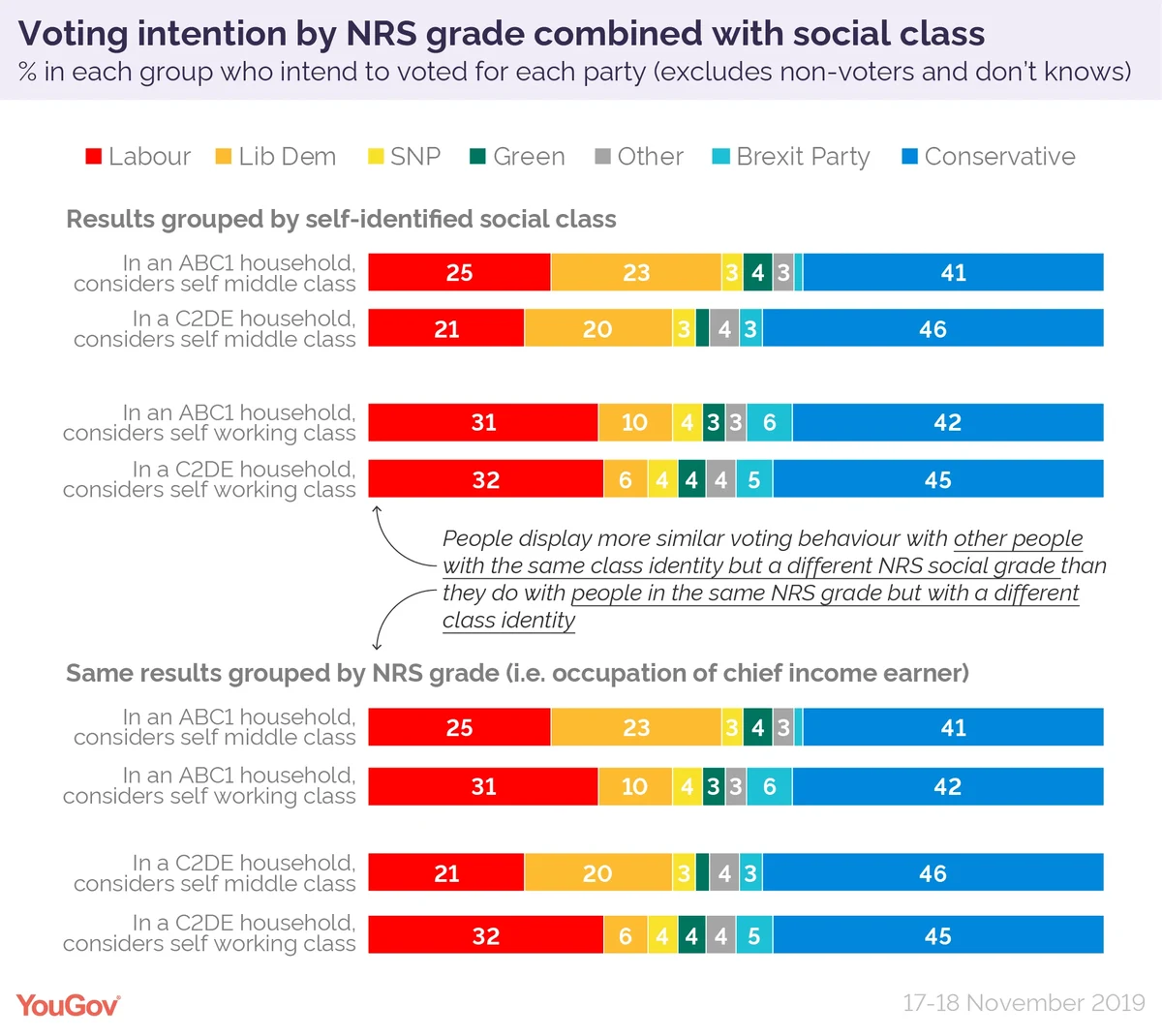
On the other side of the spectrum, however, the Conservative vote corresponds more clearly with NRS grade, although the difference in the Conservative vote between all groups is far smaller (a range of only 41-46%, compared to 21-32% for Labour and 6-23% for the Lib Dems).
To confuse matters further, the way ABC1s and C2DEs voted at the EU referendum does correspond quite strongly with the way middle and working class people voted respectively. ABC1s voted Remain over Leave by 55% to 45%, while among middle class voters those figures are 56% and 44%. There is a bigger gap between C2DEs and the working class, although both groups favoured Leave, by 62% to 38% in the case of C2DEs and by 57% to 43% in the case of working class voters.
But then combining these identities produces figures that indicate the NRS grade is a better indicator of a person’s vote than their class. ABC1 middle class people are noticeably closer to ABC1 working class people in their EU referendum vote (the former voting Remain by 60% to 40% and the latter by 51% to 49%) than they are to C2DE middle class people (who voted Leave by 57% to 43%).
Likewise C2DE working class people are more similar to their middle class companions in C2DE than their fellow working class compatriots in ABC1, with 65% voting to Leave and 35% Remain.
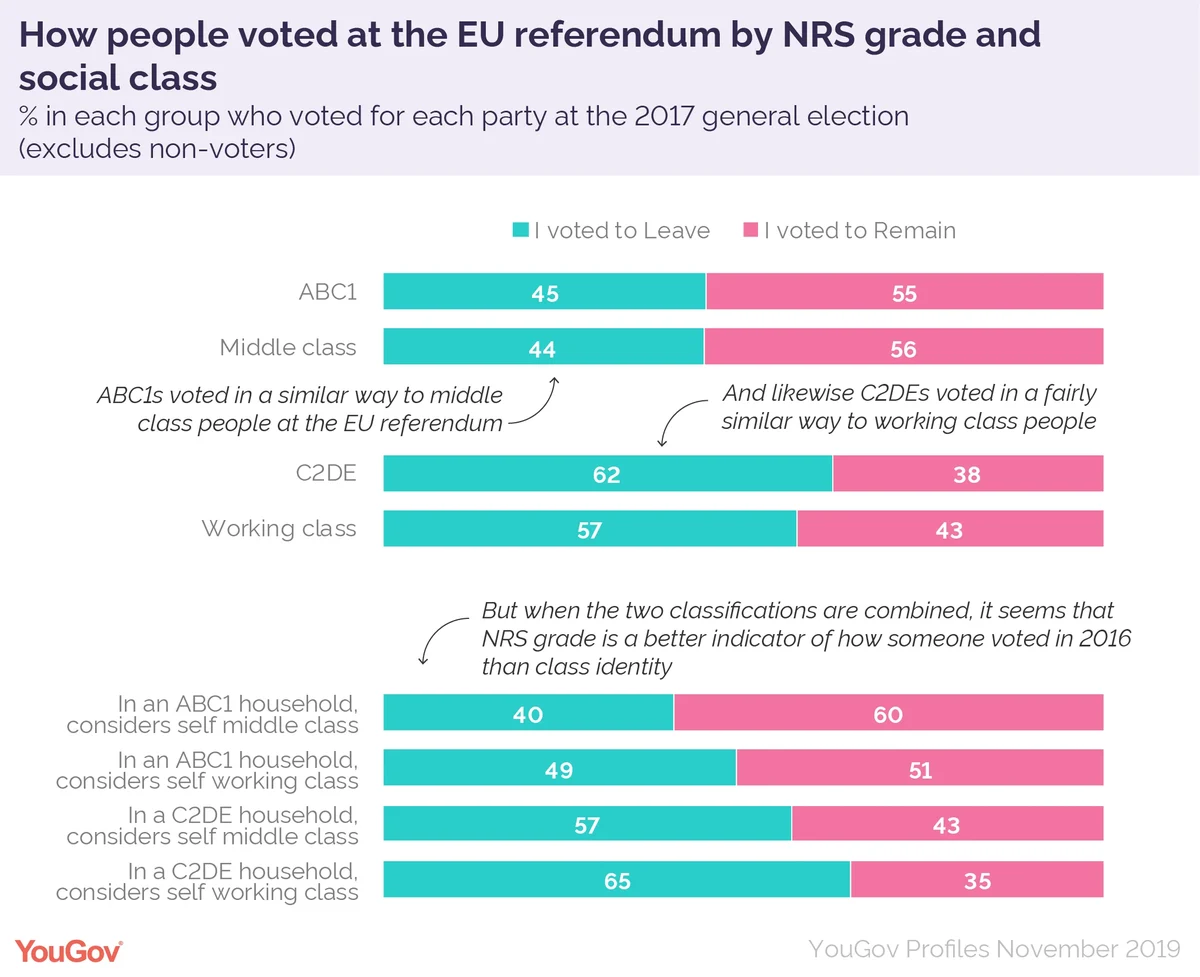
Conclusion
Ultimately the results show that how people view their class is often very different from that implied by their NRS grade – assuming it was ever correct to use ABC1/C2DE interchangeably with middle and working class.
None of this is to say that self-identified class is superior to NRS grade as a way of categorising people. For a start, 9% of Britons don’t know what class they fit in to. Additionally, the fact that so many people hold ABC1 occupations and consider themselves working class or vice versa suggests that – objectively speaking – many of them could be “wrong” about their own class. That is to say, were their circumstances compared against what people consider to be working class and middle class characteristics, most people would probably put them in a different class to the one they put themselves in.
But class, hard as it is to define, is often about more than just occupation. It might simply be that the best solution is to stop using ABC1 as though it means middle class and C2DE as though it means working class.
A note on pensioners
There is a misconception that all pensioners are classified as NRS grade E, which would have the effect of making C2DE more middle class and therefore boosting the Tory vote among a group that people are erroneously counting as working class.
As YouGov’s Anthony Wells has previously explained, this is not the case. In fact, retired people are only classified as E if they subsist only on the state pension – if they have any other form of pension they are graded based on their previous occupation.
As such, retired people are present in all NRS grades. Although they are most likely to be found in grade E, at 35% this means that fully two thirds of retired people occupy different NRS grades.
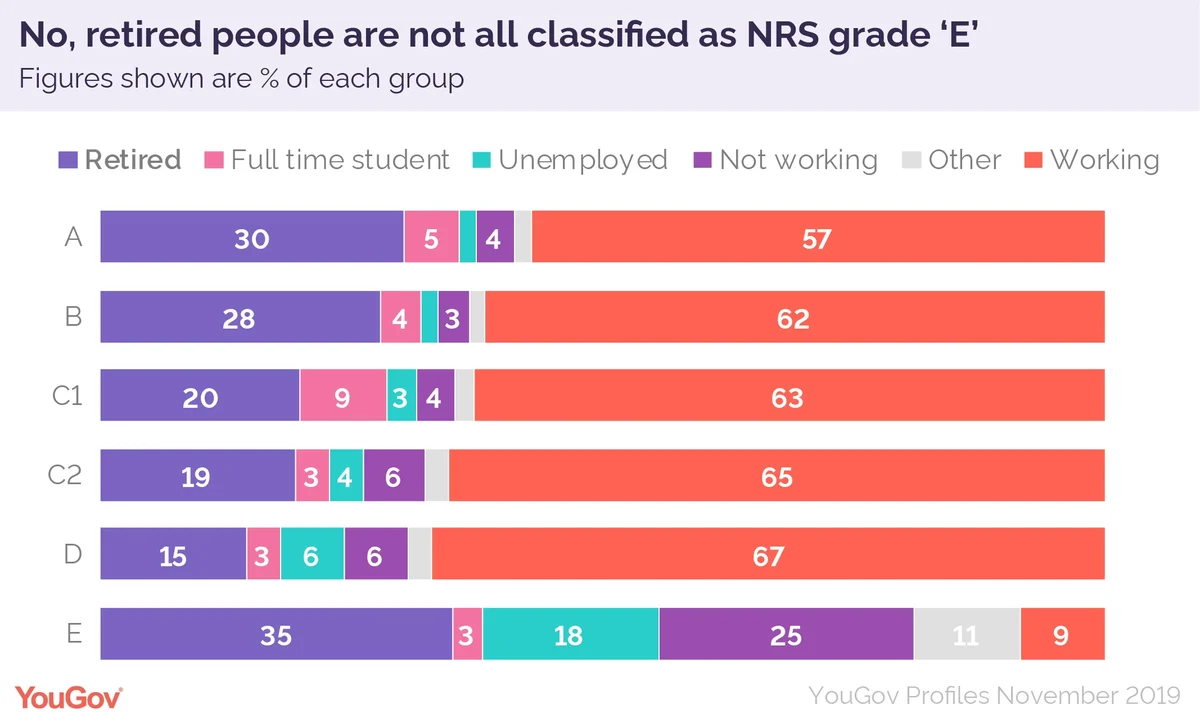
Photo: Getty










